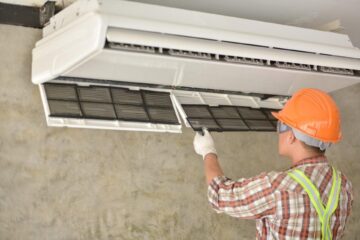Home security cameras are essential for ensuring the safety and security of your property. Technological advancements have made these cameras more accessible and efficient, providing homeowners with peace of mind. This guide explores how home security camera’s function, their key components, various types, and the benefits they offer. By understanding these aspects, you can make an informed decision about the best security camera system for your needs.
How Home Security Cameras Function
Home security cameras operate by capturing video footage of your property and transmitting it to a designated device, such as a smartphone, computer, or monitoring center. These cameras can be either wired or wireless, each with distinct operational methods.
Wired Cameras
Wired cameras are connected to a recording device and power source via cables. They generally provide stable and high-quality footage but can be challenging to install due to the need for extensive cabling.
Wireless Cameras
Wireless cameras transmit data through Wi-Fi or other wireless protocols. They are easier to install and can be placed anywhere within the range of the wireless signal. However, they may be susceptible to interference and require a strong network connection.
Most modern security cameras come equipped with motion detection sensors that activate the camera when movement is detected, conserving storage space and making it easier to review important events. Many cameras also offer night vision capabilities, allowing them to record clear footage in low-light conditions.
The recorded footage can be stored locally on a digital video recorder (DVR) or network video recorder (NVR) or uploaded to cloud storage. Local storage provides more privacy but can be at risk of damage or theft. Cloud storage offers easy access to footage from anywhere but may involve subscription fees and potential privacy concerns.
Components of Home Security Cameras
Home security cameras comprise several critical components that work together to provide effective surveillance:
Camera Lens: Determines the field of view and image quality. High-quality lenses provide clear, detailed images and can cover a wider area.
Image Sensor: Converts light into electrical signals to produce images. CMOS sensors are common in modern security cameras due to their lower cost and power consumption.
Housing: Protects the internal components from environmental factors like rain, dust, and extreme temperatures.
Infrared LEDs: Enable cameras to capture clear images in low-light or no-light conditions by illuminating the area with infrared light.
Network Connectivity: Modern security cameras typically have network connectivity options, such as Wi-Fi or Ethernet, to transmit video footage for remote viewing.
Storage: Options include local storage (SD cards, NVRs/DVRs) and cloud storage, offering access to footage and protection against tampering.
Types of Home Security Cameras
There are several types of home security cameras, each designed to meet different surveillance needs:
Indoor Cameras: Designed for monitoring the inside of your home. They are typically smaller and less obtrusive, with features like two-way audio, allowing you to communicate with family members or pets remotely.
Outdoor Cameras: Built to withstand the elements, outdoor cameras are usually weatherproof and have robust construction. They often come with features like motion detection, night vision, and a wider field of view to monitor larger areas like driveways and gardens.
Doorbell Cameras: These replace your standard doorbell and provide a video feed of your doorstep. They often include motion detection, two-way audio, and cloud storage, allowing you to see and communicate with visitors even when you’re not home.
Wireless Cameras: Offer flexibility in placement and are easy to install. They transmit data via Wi-Fi and are ideal for renters or those who do not want to run cables through their homes. However, they depend on a stable internet connection and power source.
Wired Cameras: Connected to a recording device and power source through cables, wired cameras generally offer more stable and higher-quality footage but can be more challenging to install. These systems are ideal for homeowners who need a reliable and robust surveillance solution.
Benefits of Home Security Cameras
Home security cameras provide numerous benefits that enhance the safety and security of your home:
Deterrence: Visible cameras can deter potential intruders from targeting your home, as criminals are less likely to attempt a break-in when they know they are being watched.

Evidence Collection: Security cameras provide valuable evidence in the event of a crime. High-quality footage can help identify suspects and provide crucial evidence for law enforcement, aiding in the recovery of stolen property and ensuring justice is served.
Remote Monitoring: Modern security cameras allow you to monitor your home in real-time from anywhere using a smartphone or computer. This feature is particularly useful for checking on your home while you’re away, ensuring everything is in order.
Safety for Loved Ones: Security cameras enable you to keep an eye on children, elderly family members, or pets, ensuring their well-being and allowing you to respond quickly in case of an emergency.
Insurance Benefits: Many insurance companies offer discounts for homes equipped with security systems, recognizing the reduced risk of theft and damage, which can potentially lower your homeowner’s insurance premiums.
Future Trends in Home Security Cameras
As technology continues to evolve, home security cameras are becoming more advanced and user-friendly. Future trends in this field include the integration of artificial intelligence (AI) and machine learning, which can enhance motion detection accuracy and reduce false alarms by distinguishing between humans, animals, and objects. Additionally, advancements in camera resolution, such as 4K and even higher, will provide clearer and more detailed footage, further aiding in the identification of suspects and critical events. Smart home integration is also on the rise, allowing security cameras to work seamlessly with other smart devices, such as lights and locks, to create a comprehensive home security ecosystem. These innovations will continue to improve the effectiveness and convenience of home security systems, ensuring that homeowners can protect their properties and loved ones with greater confidence and ease.
Conclusion:
Home security cameras are an essential tool for modern homeowners, offering numerous benefits that enhance safety and peace of mind. By understanding how these cameras work, the components that make them effective, and the different types available, you can choose the best outdoor camera system for your needs. Investing in a reliable home security camera system not only protects your property but also ensures the safety of your loved ones. With the right security measures in place, you can enjoy greater peace of mind knowing your home is well-protected.



